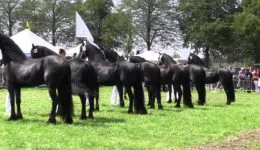Massive Herd of Elk in Montana
This video shows a huge heard crossing the road near Yellowstone. It’s located at Bozeman, MT. We have never seen such a big herd before. Poor little guy at the end. Luckily he finally caught up. What did you think of the elk crossing?
Elk migration in Yellowstone National Park is a fascinating natural phenomenon. Here are some interesting facts about it:
- Seasonal Movement: Elk in Yellowstone undertake one of the longest remaining land mammal migrations in the contiguous United States. They migrate between their winter range in the northern parts of the park and their summer range in the higher elevations of the park.
- Population Size: The northern Yellowstone elk herd is one of the largest herds in North America, with an estimated population of around 10,000 individuals.
- Altitudinal Migration: Elk undertake altitudinal migration, moving from lower elevation winter ranges to higher elevation summer ranges. During winter, they descend to lower valleys where they find milder temperatures and access to food.
- Breeding Season: Elk migration in Yellowstone is influenced by the breeding season, known as the rut, which typically occurs in the fall. During this time, the bulls compete for mating rights by bugling, displaying their antlers, and engaging in physical confrontations.
- Route Selection: The migration routes of elk in Yellowstone are not fixed and can vary from year to year. The selection of routes depends on factors such as snow depth, forage availability, and predator avoidance.
- Natural Barriers: Elk migration routes are sometimes impeded by natural barriers like deep snow or large rivers. These obstacles can influence the timing and success of migration, as elk need to find suitable crossing points.
- Predator-Prey Interaction: The migration of elk in Yellowstone also influences predator behavior. Wolves, Yellowstone’s apex predators, are known to follow the elk herds during migration, targeting weak or injured individuals.
- Ecological Impact: Elk migration plays a vital role in shaping the landscape and maintaining ecological balance in Yellowstone. Their grazing patterns can affect plant growth, and their movements help disperse seeds and nutrients.
- Human-Wildlife Interactions: Elk migration attracts a significant number of visitors to Yellowstone, providing them with opportunities to observe and appreciate this natural spectacle. Park authorities manage traffic and access points to minimize disturbances to the migrating elk.
- Research and Conservation: Scientists study elk migration in Yellowstone to understand the ecological processes and inform conservation efforts. Research helps in evaluating the impacts of climate change, habitat alteration, and human activities on elk populations and their migration patterns.
These fascinating elk migrations in Yellowstone National Park showcase the intricate relationship between wildlife, landscape, and the dynamic processes of nature.
Please let us know in the comment section below and remember to share the video and sign up for our free newsletter!





October 12, 2015 @ 8:38 am
I think the last elk was frightened by the car that came on so fast and then stopped. Otherwise it might have been caught by the wire, died and been eaten by other predators.
June 23, 2015 @ 8:46 pm
I worked in WY building a refinery in the winter….and we would ride to the top on school busses….sometimes pulled by a bulldozer….and gave us plenty of time to look around….and watched a mountain of elk moving around by the thousands….wish I had todays cellphone….
April 18, 2015 @ 11:16 am
Never saw anything like this before…and the last little guy finally figured he needed to get a running start in order to jump. WOW! I Live in NJ, have lived in Manhattan, NYC…except for zoos, never saw animals in their environment…Thank whomever sent this to me for this experience. I now live near the Jersey shore…the only things I see here are seagulls, egrets and other shore birds…
March 25, 2015 @ 6:27 am
It makes you realise what a beautiful planet we live on.
Pity the Muslims don’t agree.
BRT Australia
March 16, 2015 @ 9:07 pm
If it was barbed wire, his underside could be pretty bad torn up.
Found on two occasions disemboweled deer hanging on the wire.
This one seems to be ok.
March 14, 2015 @ 8:38 pm
Well Allan, dictionaries aren’t always correct and ELK is both singular and plural …… as in a Herd of “Elk” ….. I don’t know who thru-out time made up The Dictionary, as a standard I guess for English, but I myself think they incorporated ‘their beliefs’ into what is correct and not. Elk are a very beautiful animal and being around them is a awesome experience. Those people that truly live with them are very blessed.
March 14, 2015 @ 6:35 pm
Really cool, but the correct term in English is GANG of Elks, not herd. Not that the last guy looks like a gang member 🙂 but that’s the dictionary term.
October 12, 2015 @ 8:55 am
Maybe in England, when dictionaries were first written, the word was “gang,” but word usages change. In Elk country, the word is herd.
February 1, 2015 @ 9:45 pm
I don’t live at the mountains, but have hunted there. About 55 years ago we were hunting around Jackson hole, Wyoming. We did not get our elk, but I saw them on Antelope Flats the space between tree lines, north of the feed ground and Jackson. When the snow gets deep and they can’t find food they come onto the feed grounds where your license fees buy hay to feed them, there were thousands of them not worried it was hunting season and within 100 yards of the tree line. You could only shoot them when they were in the trees, and they knew that so they stayed out where you could take pictures, I did. From the snow I would guess they are headed for one of the feed grounds. If you can not tell if the meat tastes like deer or beef – that is elk, buffalo tastes like beef, but leaner. Deer is my favorite meat.
Want to help the elk? Buy a hunting license but do not hunt. I am James Elmer 🙂
January 22, 2015 @ 4:04 pm
At least his buddies waited up for him!
January 19, 2015 @ 9:34 am
Never seen such before. The concern that the other elks have for the one that was left behind is a lesson that human beings have to learn from them. In this fast world no one ever thinks of the other!